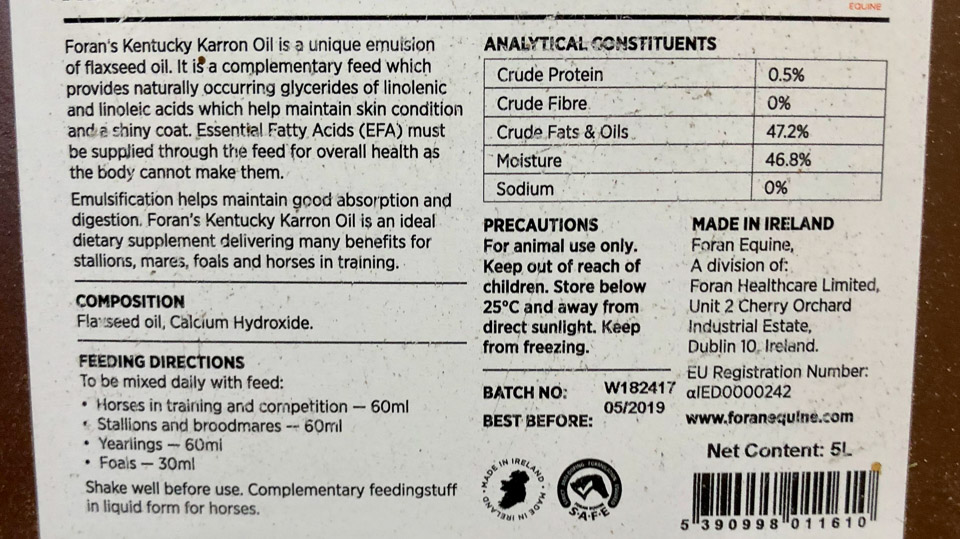
Horse Nutrition – Fats
Other words for fat include triglycerides, fatty acids, omega fatty acids, MCT oil, saturated, monounsaturated and polyunsaturated fats, Omega fatty acids and essential fats.
Fats are made up of a chain of carbons with hydrogens and oxygens attached to the chain. The length of the carbon chain determines if it is a short chain (6 or less carbons), a medium chain (6 to 12 carbons and called medium chain triglycerides or MCT oil in humans), long chain (13 to 21 carbons including EPA) and very long chain (more than 22 carbons including DHA). Horses and humans can make long chains by adding to shorter chains. An example of this is the creation from alpha-linolenic acid into EPA (eicosapentaenoic acid – 20 carbons) and then into DHA (docosahexaenoic acid – 22 carbons).
**CONTINUED IN ARTICLE TAB**
Related material – Sometimes I have a lot of material here that I have written, podcasted, video blogs and other things. They will be listed in this tab.
Use the browser back button or menu to return to the index of topics.
⬇︎ CLICK ANY IMAGE BELOW TO REVEAL MORE INFORMATION There are no images
Other words for fat include triglycerides, fatty acids, omega fatty acids, MCT oil, saturated, monounsaturated and polyunsaturated fats, Omega fatty acids and essential fats.
Fats are made up of a chain of carbons with hydrogens and oxygens attached to the chain. The length of the carbon chain determines if it is a short chain (6 or less carbons), a medium chain (6 to 12 carbons and called medium chain triglycerides or MCT oil in humans), long chain (13 to 21 carbons including EPA) and very long chain (more than 22 carbons including DHA). Horses and humans can make long chains by adding to shorter chains. An example of this is the creation from alpha-linolenic acid into EPA (eicosapentaenoic acid – 20 carbons) and then into DHA (docosahexaenoic acid – 22 carbons).
Humans have 2 “essential fatty acids” because they cannot synthesize them. They are alpha-linolenic acid (ALA – which are the Omega 3’s) and linoleic acid (LA – the Omega 6 fatty acids). Humans supplement their diet with flax seeds, chia seeds, hemp and several other plants to get these essential fatty acids but there is no evidence that horses need to consume them. This said, the current movement is to supply ALA and LA to horses in their diet via supplementation. But there is little research indicating the need nor are there diseases showing a deficiency in these fatty acids. As far as I can ubnderstand it, these “essential fatty acids” in humans can be constructed in a yet unknown pathway from the short chain fatty acids derrived from bacterial digestion of cellulose. Where I believe any problem exists is where horses are fed grain diets throughout the year which disrupts the bacteria normally living in the hind gut and this leads to a reduction in the formation of short chain fatty acids.
The fatty acids can attach their hydrogens either to each carbon (a saturated fat), to all by one carbon (an unsaturated fat) or they can skip several carbons (a polyunsaturated fat). The first carbon in a chain is called the “alpha” and the last carbon in the chain is called the “omega.” To hold the longer chains together, some of the carbons attach to each other with 2 bonds rather than the usual 1 bond. These are called “double bonds” and the location of the 1st double bond is counted from the last carbon. If it occurs at the 3rd carbon from the end then the fat is called an “Omega 3 fatty acid” and if it occurs at the 5th carbon from the end it is called an “Omega 6 fatty acid.” If there are 20 carbons with 5 total double bonds then it is called eicosa- (20) -penta (5) -enoic acid or EPA. 22 carbons with 6 double bonds is called docosa- (20) -hexa- (6) enoic acid or DHA. Both of these are Omega 3 fatty acids.
Cellulose is the structural carbohydrates of plants. It is created by linking together glucose (sugar) molecules into a long chain with every other glucose molecule upside down compared to the ones on each side. When the horse eats cellulose the bacteria in the hind gut (the colon) break this chain down to form short chain fatty acids (butyrate, pyruvate and acetate). These are fats that can be stored, can be used as fuel or can be built upon to create longer chain fatty acids (fats). Feeding your horses cellulose is feeding them a fat diet and is essential to their existence, assuming a healthy gut microbiota.
When used as a fuel, fatty acids yield 20 to 28 times MORE energy than glucose. This is why horses do so well on winter pasture. They are consuming plants low in starch (glucose) and high in cellulose (fat). They will, by spring, lose body fat on this diet but they will be satiated, will restore the health of the cells through hormesis and will maintain their muscles. There is no need to add any other fat in their diet.
Articles
- The Basics of Sugar, Fat and Proteins – Decomplexicating Equine Nutrition Part 2 of 12
- The High Fat Diet – Decomplexicating Equine Nutrition Part 7 of 12
Podcasts
The Horsemanship Nutrition Course – included in the membership.


Responses